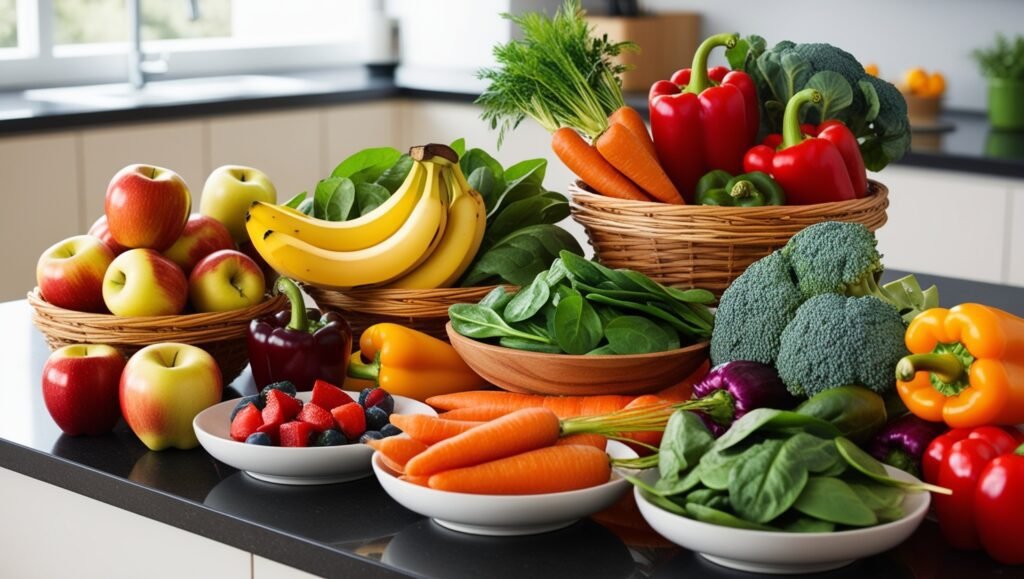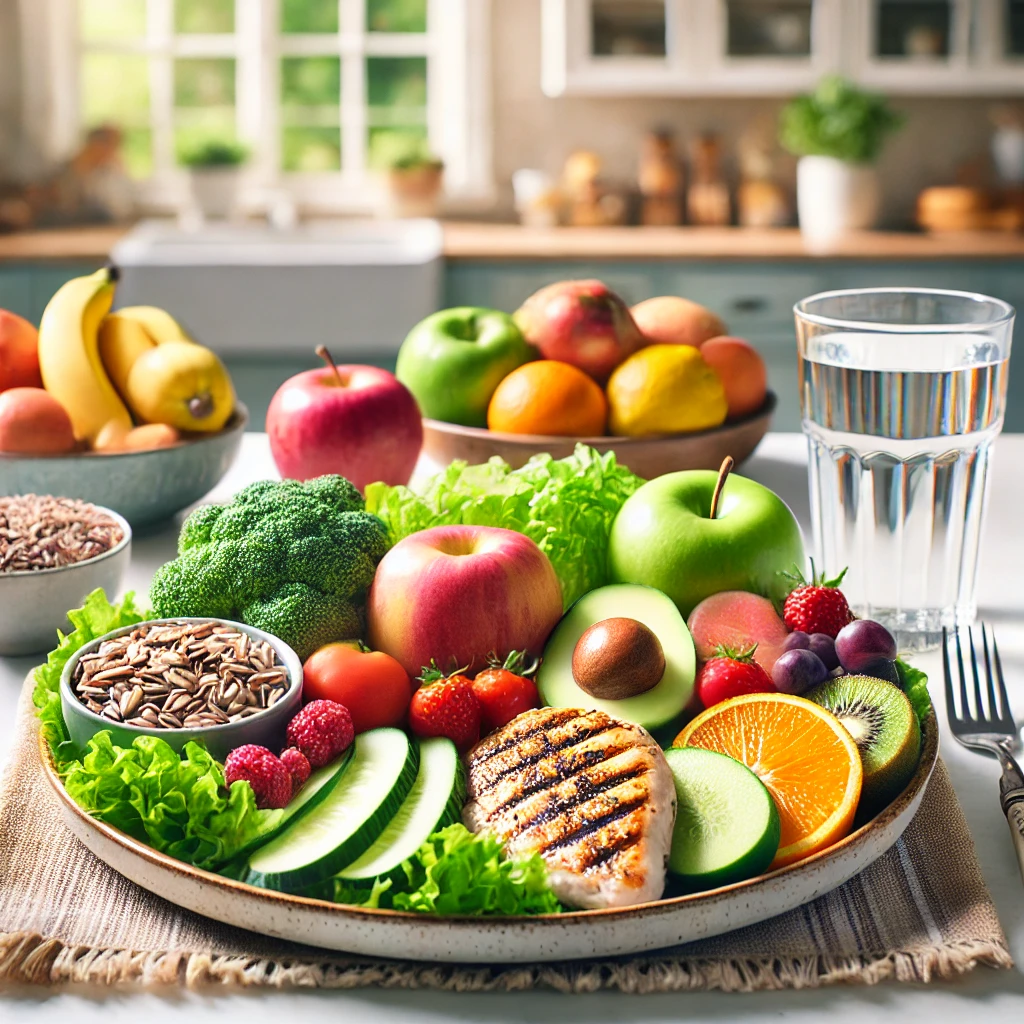The DASH diet has gained significant recognition as one of the healthiest eating plans for promoting cardiovascular health, controlling high blood pressure, and fostering overall well-being. Standing for Dietary Approaches to Stop Hypertension, the DASH diet has been consistently recommended by healthcare professionals and nutritionists for people aiming to improve heart health, lose weight, and maintain balanced nutrition.
This comprehensive guide will cover everything you need to know about this diet, from its basic principles and health benefits to practical tips for meal planning and success. Whether you’re looking to control hypertension or adopt a healthier eating pattern, the DASH diet could be the answer.
Table of Contents
1. What is the DASH Diet?

The DASH diet, developed by the U.S. National Institutes of Health (NIH), was designed with one primary goal: to lower blood pressure without the need for medication. It emphasizes eating nutrient-dense foods that are low in sodium but rich in potassium, magnesium, and calcium—three minerals essential for maintaining healthy blood pressure levels.
The diet also emphasizes the consumption of fruits, vegetables, whole grains, lean proteins, and low-fat dairy while limiting the intake of red meat, sugary beverages, and processed foods.
2. The Science Behind the DASH Diet
This diet has been extensively researched and is supported by robust scientific evidence. Studies show that individuals who follow this diet can significantly lower their systolic and diastolic blood pressure. A major clinical trial known as the DASH-Sodium study found that reducing sodium intake, in combination with the DASH diet, led to even greater reductions in blood pressure.
Blood Pressure Reduction Statistics from DASH Studies
| Blood Pressure Type | Reduction with DASH Diet |
|---|---|
| Systolic Blood Pressure | 8-14 mm Hg |
| Diastolic Blood Pressure | 5-10 mm Hg |
These reductions, particularly for systolic blood pressure, are similar to what some individuals achieve through medications, making the DASH diet an effective and natural alternative for controlling hypertension.
3. How Does It Work
It is designed to provide daily and weekly nutritional goals. For an average 2,000-calorie diet, the following servings are recommended:
| Food Group | Servings per Day | Example Foods |
|---|---|---|
| Grains | 6-8 | Whole-wheat bread, brown rice, oatmeal |
| Vegetables | 4-5 | Leafy greens, carrots, tomatoes, broccoli |
| Fruits | 4-5 | Apples, bananas, berries, citrus fruits |
| Low-fat Dairy | 2-3 | Skim milk, low-fat yogurt, reduced-fat cheese |
| Lean Protein (Meats) | 2 or less | Skinless poultry, fish, lean cuts of beef |
| Nuts, Seeds, Legumes | 4-5 per week | Almonds, kidney beans, lentils, sunflower seeds |
| Fats and Oils | 2-3 | Olive oil, avocado, margarine |
| Sweets | 5 or fewer per week | Jellybeans, sorbet, honey |
The key is portion control, variety, and focusing on nutrient-rich foods that provide the vitamins, minerals, and fiber needed for a healthy cardiovascular system.
4. Health Benefits of the DASH Diet
1. Lowering Blood Pressure
The primary benefit of the DASH diet is its ability to lower high blood pressure (hypertension). By reducing sodium and increasing the intake of heart-healthy minerals like potassium, magnesium, and calcium, the diet directly combats the leading causes of high blood pressure.
2. Weight Loss
Though not designed explicitly as a weight loss diet, the DASH diet often leads to weight reduction because of its focus on nutrient-dense, low-calorie foods. By eliminating processed foods and refined sugars, most people naturally consume fewer calories while still feeling satisfied.
3. Reduced Risk of Heart Disease
Numerous studies have shown that following the DASH diet not only lowers blood pressure but also reduces cholesterol levels, leading to a reduced risk of heart attacks and strokes.
4. Lower Risk of Diabetes
By emphasizing whole grains, lean proteins, and low-fat dairy, the DASH diet helps regulate blood sugar levels. As a result, it has been linked to a lower risk of developing type 2 diabetes.
5. Improved Kidney Health
High blood pressure and excessive sodium intake can strain the kidneys, leading to kidney disease. The DASH diet’s low sodium content, combined with its emphasis on nutrient-rich foods, helps protect kidney function over time.
5. How It Helps to Reduce Hypertension
One of the key reasons the DASH diet is effective in reducing blood pressure is its emphasis on specific nutrients that play a direct role in regulating blood pressure.
1. Potassium
Potassium helps balance the effects of sodium in the body. When potassium intake increases, sodium is flushed out of the body through urine. This process helps reduce blood pressure.
2. Magnesium
Magnesium works by relaxing blood vessels, which lowers blood pressure and improves overall circulation. Studies show that people who consume adequate amounts of magnesium are less likely to develop hypertension.
3. Calcium
Calcium is essential for maintaining healthy blood vessels. It helps the smooth muscle cells in the blood vessel walls relax and contract efficiently, which helps regulate blood pressure.
By focusing on foods that are rich in these nutrients, such as fruits, vegetables, and low-fat dairy, the DASH diet naturally supports the cardiovascular system.
6. Foods to Eat and Avoid
The DASH diet focuses on eating whole, minimally processed foods while reducing sodium and unhealthy fats. Here’s a breakdown of foods to include and avoid:
Foods to Eat on the DASH Diet:
- Fruits and Vegetables: Fresh or frozen, these should be a staple.
- Whole Grains: Brown rice, quinoa, whole-wheat pasta, and oats.
- Lean Proteins: Skinless chicken, turkey, fish, and plant-based proteins like beans and lentils.
- Low-fat Dairy: Skim milk, low-fat yogurt, and reduced-fat cheeses.
- Nuts and Seeds: Almonds, sunflower seeds, and flaxseeds in moderation.
Foods to Limit or Avoid:
- High-Sodium Foods: Processed meats, canned soups, and salty snacks.
- Sugary Beverages and Sweets: Soda, candy, baked goods with high sugar content.
- Red and Processed Meats: Beef, pork, bacon, and sausages should be consumed sparingly.
- Full-fat Dairy: High-fat cheeses, whole milk, and cream should be avoided.
7. Sample DASH Diet Meal Plan

Here’s a one-day sample menu to give you a better idea of what eating on the DASH diet looks like:
Breakfast
- Oatmeal topped with sliced bananas and a handful of almonds
- 1 cup of low-fat milk
- Herbal tea
Lunch
- Grilled chicken salad with mixed greens, cherry tomatoes, cucumbers, and a light vinaigrette
- Whole-grain bread with a slice of low-fat cheese
- 1 apple
Snack
- Carrot sticks with hummus
- A handful of unsalted almonds
Dinner
- Baked salmon with quinoa and steamed broccoli
- 1 cup of low-fat yogurt with a drizzle of honey for dessert
This meal plan incorporates a variety of food groups and focuses on heart-healthy nutrients, providing balanced nutrition throughout the day.
8. Practical Tips

Adopting the DASH diet may require some adjustments, but these tips will help make the transition smoother:
- Start Slow: Gradually introduce more fruits, vegetables, and whole grains into your meals.
- Read Food Labels: Check for sodium content in packaged foods, aiming for less than 2,300 mg per day (or 1,500 mg for greater blood pressure reduction).
- Plan Your Meals: Meal planning helps you stick to the diet by ensuring you have healthy, DASH-approved options available.
- Watch Portion Sizes: It’s important to stick to recommended portion sizes to ensure calorie control.
- Stay Hydrated: Drinking plenty of water helps your body process the increased fiber from fruits, vegetables, and whole grains.
9. DASH Diet vs. Other Popular Diets
While the DASH diet focuses primarily on heart health and lowering blood pressure, it also shares some similarities with other popular diets. However, there are key differences:
- DASH Diet vs. Mediterranean Diet: Both diets emphasize whole foods, lean proteins, and healthy fats. However, the Mediterranean diet encourages more olive oil and seafood, while the DASH diet focuses on reducing sodium intake.
- DASH Diet vs. Keto Diet: The DASH diet includes more carbohydrates from whole grains and fruits, whereas the Keto diet restricts carbs to promote fat loss.
- DASH Diet vs. Paleo Diet: While both diets emphasize natural foods, the Paleo diet excludes grains and dairy, both of which are key components of the DASH diet.
10. Conclusion: Is the DASH Diet Right for You?
If you’re looking for a scientifically backed, nutrient-dense, and sustainable way to improve your health, particularly heart health, the DASH diet is an excellent choice. It’s not only effective in lowering blood pressure but also promotes overall wellness, including weight management, improved cholesterol levels, and reduced risk of chronic diseases.
By making gradual changes to your eating habits and incorporating the DASH principles, you can enjoy long-lasting health benefits. Always consult with a healthcare professional before making significant dietary changes, especially if you have existing health conditions.
References
- National Heart, Lung, and Blood Institute. (2021). “Your Guide to Lowering Your Blood Pressure with DASH.”
- Sacks, F. M., Svetkey, L. P., Vollmer, W. M., et al. (2001). “Effects on Blood Pressure of Reduced Dietary Sodium and the Dietary Approaches to Stop Hypertension Diet.” New England Journal of Medicine.
- Appel, L. J., Moore, T. J., Obarzanek, E., et al. (1997). “A Clinical Trial of the Effects of Dietary Patterns on Blood Pressure.” New England Journal of Medicine.




